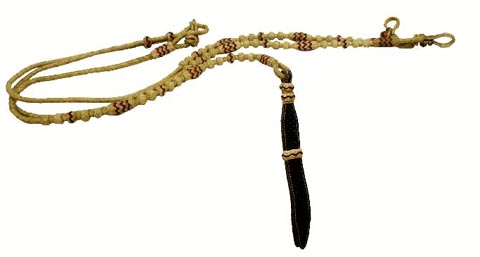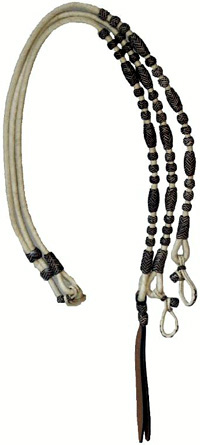
There are many different kinds of reins but rawhide romal reins are somewhat unique. Think of the letter Y upside down where the rider holds on to the single part and the two sides go down each side and fasten on the bit. This is called a closed rein because it helps prevent the rider from dropping the reins (which can easily happen when you are roping or doing ranch work).
The rein is made up of leather strands or plaits that are braided together. The number of plaits used make for different diameters. A typical rider uses a 30-plait romal that is 108 inches in total length. If you are using chains between the bit connection and the rein you will need a shorter length and different horses have different length necks so you need to be clear about what you want.
You need to be a little careful because the plaits can be different thicknesses. The smaller the plait thickness generally the softer the rein which means it won’t need to be broken in as much. But the smaller size means a narrower diameter.
You want to keep them out of the sun when not in use – they dry out – and frequently use something like Vaquero Rawhide Cream to keep them conditioned.
 As with any handmade leather good, workmanship counts! You’ll see cheaper romals around but look carefully at how even the diameter is, are the different “weaves” exactly the same, and of course test how soft it is. At the rider end of the romal typically there is a leather quirt like piece or popper and that can have no or fancy engraving on it. And there can be all kinds of decoration, typically larger colored leather pieces woven into the rein.
As with any handmade leather good, workmanship counts! You’ll see cheaper romals around but look carefully at how even the diameter is, are the different “weaves” exactly the same, and of course test how soft it is. At the rider end of the romal typically there is a leather quirt like piece or popper and that can have no or fancy engraving on it. And there can be all kinds of decoration, typically larger colored leather pieces woven into the rein.
The bad news is that if really well made they are expensive – $500-600 range – but the good news is if you take care of them they will last a lifetime. There are ones available for $60 and up but you pretty much get what you pay for.
There is a “correct” way to hold romal reins (at least according to competition judges). Your left hand grips the reins right at the spot where the Y converges into one rein with one rein coming out of the top of your fist, two reins coming out the bottom. And your right hand grips the one rein about 16 inches from your left hand and rests on your right thigh. Obviously your horse needs to be good at neck reining because that is the primary way you will communicate where you want him to go.
There are many many talented makers of romal reins. My personal favorite is Steve Guitron in Vista, California.
